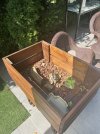You are using an out of date browser. It may not display this or other websites correctly.
You should upgrade or use an alternative browser.
You should upgrade or use an alternative browser.
Help identifying tortoise species and gender!!
- Thread starter Juliaboris
- Start date
- Joined
- Dec 27, 2016
- Messages
- 9
Thanks for your input. Do you have any recommendations for us? She lives in a third world country so we don’t have the resources for her to see a vet or anything. We try to hydrate the shell as much as we can but would love to know if there’s anything else we can do (or give her)Her shell to me looks underdeveloped and considerably pyramided, and she may have MBD, metabolic bone disease...just honestly how it looks to me, and maybe I am mistaken.
Mr. RussianTortoise
Well-Known Member
Let's try to find out what the problem is thats causing the shell problem. It would be extremely helpful if you could tell us the diet, temp, humidity, substrate, enclosure, and lighting for your tortoise. We can start from there. 
I am not any of the names Tammy wants...but ...The tortoise is pyramiding...it needs a better diet and 80% or more humidity...Certainly in whatever country he's in... a box with humidity in it wouldn't be that hard to accomplish? Hydrating her shell is not going to do the job. It needs 80% or more humidity all the time...example...
I keep a tortoise who also needs high humidity in here. I got this off Amazon...can you get on the internet? Can you order from Amazon? You could lay a bookcase on it's back and put something like this over it...he needs substrate to bury in and walk on and a moistened substrate will create humidity.

I personally think that without big changes that tortoise has the chance of looking like this...
This is what medium pyramiding looks like. This is also bad, see her jaw?
Your tort needs a change of diet, habitat and humidity. He should be in a container, not running free...
Did anyone give you this? If you have a Chaco, this will help, if it's Sulcata it will still help...
Desert Tortoise Care Sheet
I keep a tortoise who also needs high humidity in here. I got this off Amazon...can you get on the internet? Can you order from Amazon? You could lay a bookcase on it's back and put something like this over it...he needs substrate to bury in and walk on and a moistened substrate will create humidity.

I personally think that without big changes that tortoise has the chance of looking like this...

This is what medium pyramiding looks like. This is also bad, see her jaw?

Your tort needs a change of diet, habitat and humidity. He should be in a container, not running free...
Did anyone give you this? If you have a Chaco, this will help, if it's Sulcata it will still help...
Desert Tortoise Care Sheet
- Joined
- Dec 27, 2016
- Messages
- 9
Thank you all for giving your input! I greatly appreciate it. Boris lives in Montevideo, Uruguay where there is no Amazon or honestly any resources to find big cases to put her in. It was a mission to even find something that she would fit in. This is one of the main reasons why I wanted to bring her back to the US with me. Just because I feel like there are more resources for her. @Maggie3fan thanks so much for that picture. I’m am going to do some research and see if I can maybe bring something back from the states next time I come. By any chance do you have a picture of the substrate you use? Thank you all!!
How about a bookcase? Take out the shelves, and line it with a shower curtain fill with orchid barkThank you all for giving your input! I greatly appreciate it. Boris lives in Montevideo, Uruguay where there is no Amazon or honestly any resources to find big cases to put her in. It was a mission to even find something that she would fit in. This is one of the main reasons why I wanted to bring her back to the US with me. Just because I feel like there are more resources for her. @Maggie3fan thanks so much for that picture. I’m am going to do some research and see if I can maybe bring something back from the states next time I come. By any chance do you have a picture of the substrate you use? Thank you all!!

How about a bookcase? Take out the shelves, and line it with a shower curtain fill with orchid bark. Frankly, I don't have a clue what living in a country like that would be...I am a very spoiled American, couldn't live w/out Amazon Prime to send me whatever I need or want...

- Joined
- Dec 27, 2016
- Messages
- 9
Boris’ diet consists of kale, lettuce, carrots, pumpkin, and occasionally we give her apples and blueberries. I have attached the average temp and humidity in Uruguay. We don’t have central AC. Her routine is to get some hours of direct sunlight during the day. We supervise her walking around when she is not sleeping. We don’t have a lamp on her because they do not sell UV lamps here. I also provided a picture of her enclosure. Some context: I got Boris as a gift when I was 14. I am now 24. She has lived 10 years in Uruguay now. Just yesterday we realized that she is a Chaco. This whole time we thought she was a sulcata due to a post I posted here on the forum back in 2016.Let's try to find out what the problem is thats causing the shell problem. It would be extremely helpful if you could tell us the diet, temp, humidity, substrate, enclosure, and lighting for your tortoise. We can start from there.
Attachments
Thanks for posting the pictures. Please try to follow the great advice offered! Opuntia cactus would be a good addition to her diet, which needs much improvement too. Stay with us please, we all want to help!
No fruit..her kidneys can't process the sugar like ours can. I guess I'm not gonna give you any lectures...because somehow it is working for you and the tortoise...she probably isn't going to pyramid any more than she is...Boris’ diet consists of kale, lettuce, carrots, pumpkin, and occasionally we give her apples and blueberries. I have attached the average temp and humidity in Uruguay. We don’t have central AC. Her routine is to get some hours of direct sunlight during the day. We supervise her walking around when she is not sleeping. We don’t have a lamp on her because they do not sell UV lamps here. I also provided a picture of her enclosure. Some context: I got Boris as a gift when I was 14. I am now 24. She has lived 10 years in Uruguay now. Just yesterday we realized that she is a Chaco. This whole time we thought she was a sulcata due to a post I posted here on the forum back in 2016.
- Joined
- Nov 17, 2013
- Messages
- 3,394
Although the tortoise does have pyramiding, I don't think it has metabolic bone disease from what I can see in the pictures, which is good news.Thanks for your input. Do you have any recommendations for us? She lives in a third world country so we don’t have the resources for her to see a vet or anything. We try to hydrate the shell as much as we can but would love to know if there’s anything else we can do (or give her)
You could soak the tortoise in lukewarm water for about 20-30 minutes daily which should help prevent more pyramiding. Also try to improve the diet as suggested by others. Another thing would be to sprinkle the tortoise's foods with Ultrafine Rep-Cal (with vitamin D3) and Herptivite several times weekly (if not daily).
Perhaps you could buy the two above items here in the US and send them to your relatives who are keeping the tortoise. Here is a link to a good source for both in the US. Rep-Cal is on sale this month:
Good luck with your tortoise.
It is too late to do anything about the pyramiding now. I know next to nothing about Chaco tortoises but I think @turtlesteve might keep them. If your local climate matches their native range, I suspect that their care would be similar to Desert Tortoises kept outdoors in the US Southwest.
The diet needs some serious improvement and she needs a significantly larger enclosure than the one you posted photos of. She needs to be able to roam around.
The chances of you being able to bring her to the US are slim to none. She is a CITES appendix II animal and would require a lot of paperwork. Uruguay would have to allow her to be exported to the US and generate all sorts of paperwork/permits then the US would have to allow her to be imported from Uruguay and there would be more paperwork and permits on this end. Sometimes it can be a little easier when dealing with a single pet animal but I wouldn't count on it. You would probably need to start by talking to your argriculture department or try to find an exporter/broker that deals with animals. They are typically located around major airports.
I think that chacos might be highly endangered in parts of their native range. Maybe you could consider searching for a conservation group that works with them in your area and see if they would be interested in her. If she has a known origin and has never been exposed to any other reptiles she might be valuable for conservation purposes.
The diet needs some serious improvement and she needs a significantly larger enclosure than the one you posted photos of. She needs to be able to roam around.
The chances of you being able to bring her to the US are slim to none. She is a CITES appendix II animal and would require a lot of paperwork. Uruguay would have to allow her to be exported to the US and generate all sorts of paperwork/permits then the US would have to allow her to be imported from Uruguay and there would be more paperwork and permits on this end. Sometimes it can be a little easier when dealing with a single pet animal but I wouldn't count on it. You would probably need to start by talking to your argriculture department or try to find an exporter/broker that deals with animals. They are typically located around major airports.
I think that chacos might be highly endangered in parts of their native range. Maybe you could consider searching for a conservation group that works with them in your area and see if they would be interested in her. If she has a known origin and has never been exposed to any other reptiles she might be valuable for conservation purposes.
- Joined
- Sep 23, 2012
- Messages
- 716
@Juliaboris
1. This is a Chaco tortoise. I am 100% certain. The reason it was initially incorrectly identified as a sulcata tortoises is that so few people in the US have actually seen or worked with Chaco tortoises.
2. I am pretty sure you actually have a male, not a female. This is based on the long/large tail and the overall shape of the shell. Females would be a little bit larger at this age and would have a rounder shaped shell and a much shorter tail. For having a single tortoise as a pet, this is a good thing. Males have a more outgoing personality, and much lower health risks. It is common for females to have health issues when producing eggs, even if never kept with a male.
3. He is fully grown and will not really get any larger.
4. There is some pyramiding (abnormal growth of the shell, hence the "bumpy" look). This would have been caused mainly by being too dry when he was growing many years ago. There is nothing you can do about it now and increasing humidity now won't matter much. Honestly he doesn't really look that bad, it is common to see them much worse than this here in the US. This species is extremely prone to abnormal shell growth if care isn't perfect, and these issues are usually caused by misunderstanding of their needs.
5. I don't see any evidence of metabolic bone disease or other health issues. If you wish to change his enclosure I would recommend a larger pen at ground level, and to plant it with edible weeds/grasses to create a more natural habitat. The climate there is pretty good for the species, but it does look like you get rain in winter. Is he kept outdoors all year? I don't risk leaving mine out in winter (we get winter rain here too) because of the potential for respiratory infection.
6. Chaco tortoises actually digest fruit fairly well, their diet in the wild contains some fruit, up to around 15%. A favorite food for the species is often cactus pads and fruit (prickly pear / Opuntia cactus). I do not think the fruits/pumpkin/carrots are a big problem, just try to keep them to about 15% of the total food intake, and lower sugar fruits are generally more healthy. If there is one I would feed less of it's apples, since they've been cultivated over time to have high sugar content. The other 85% of the diet should be a mix of leafy greens, edible weeds, and cactus pads.
7. I do think it would be possible to get paperwork to bring him to the US but it may take some effort and cost. If you want to go this route, the easiest thing to do is find someone who knows the process and would be able to help you. In Uruguay, the only person I can think of is David Fabius. He breeds Chaco tortoises as well as several other species, and is familiar with the international permitting and shipping process. His website is here: https://dfabius.tripod.com/
Steve
1. This is a Chaco tortoise. I am 100% certain. The reason it was initially incorrectly identified as a sulcata tortoises is that so few people in the US have actually seen or worked with Chaco tortoises.
2. I am pretty sure you actually have a male, not a female. This is based on the long/large tail and the overall shape of the shell. Females would be a little bit larger at this age and would have a rounder shaped shell and a much shorter tail. For having a single tortoise as a pet, this is a good thing. Males have a more outgoing personality, and much lower health risks. It is common for females to have health issues when producing eggs, even if never kept with a male.
3. He is fully grown and will not really get any larger.
4. There is some pyramiding (abnormal growth of the shell, hence the "bumpy" look). This would have been caused mainly by being too dry when he was growing many years ago. There is nothing you can do about it now and increasing humidity now won't matter much. Honestly he doesn't really look that bad, it is common to see them much worse than this here in the US. This species is extremely prone to abnormal shell growth if care isn't perfect, and these issues are usually caused by misunderstanding of their needs.
5. I don't see any evidence of metabolic bone disease or other health issues. If you wish to change his enclosure I would recommend a larger pen at ground level, and to plant it with edible weeds/grasses to create a more natural habitat. The climate there is pretty good for the species, but it does look like you get rain in winter. Is he kept outdoors all year? I don't risk leaving mine out in winter (we get winter rain here too) because of the potential for respiratory infection.
6. Chaco tortoises actually digest fruit fairly well, their diet in the wild contains some fruit, up to around 15%. A favorite food for the species is often cactus pads and fruit (prickly pear / Opuntia cactus). I do not think the fruits/pumpkin/carrots are a big problem, just try to keep them to about 15% of the total food intake, and lower sugar fruits are generally more healthy. If there is one I would feed less of it's apples, since they've been cultivated over time to have high sugar content. The other 85% of the diet should be a mix of leafy greens, edible weeds, and cactus pads.
7. I do think it would be possible to get paperwork to bring him to the US but it may take some effort and cost. If you want to go this route, the easiest thing to do is find someone who knows the process and would be able to help you. In Uruguay, the only person I can think of is David Fabius. He breeds Chaco tortoises as well as several other species, and is familiar with the international permitting and shipping process. His website is here: https://dfabius.tripod.com/
Steve
- Joined
- Dec 27, 2016
- Messages
- 9
Thank you so so much for all of this information, it has been so so helpful. During the winter, he is kept indoors because he hibernates. We usually put him in a dirt container so that he could burrow. By any chance do you know what their life expectancy is? Also, for an outside enclosure, what measurements would you suggest? Is the enclosure that I shared a good space for when he hibernates??@Juliaboris
1. This is a Chaco tortoise. I am 100% certain. The reason it was initially incorrectly identified as a sulcata tortoises is that so few people in the US have actually seen or worked with Chaco tortoises.
2. I am pretty sure you actually have a male, not a female. This is based on the long/large tail and the overall shape of the shell. Females would be a little bit larger at this age and would have a rounder shaped shell and a much shorter tail. For having a single tortoise as a pet, this is a good thing. Males have a more outgoing personality, and much lower health risks. It is common for females to have health issues when producing eggs, even if never kept with a male.
3. He is fully grown and will not really get any larger.
4. There is some pyramiding (abnormal growth of the shell, hence the "bumpy" look). This would have been caused mainly by being too dry when he was growing many years ago. There is nothing you can do about it now and increasing humidity now won't matter much. Honestly he doesn't really look that bad, it is common to see them much worse than this here in the US. This species is extremely prone to abnormal shell growth if care isn't perfect, and these issues are usually caused by misunderstanding of their needs.
5. I don't see any evidence of metabolic bone disease or other health issues. If you wish to change his enclosure I would recommend a larger pen at ground level, and to plant it with edible weeds/grasses to create a more natural habitat. The climate there is pretty good for the species, but it does look like you get rain in winter. Is he kept outdoors all year? I don't risk leaving mine out in winter (we get winter rain here too) because of the potential for respiratory infection.
6. Chaco tortoises actually digest fruit fairly well, their diet in the wild contains some fruit, up to around 15%. A favorite food for the species is often cactus pads and fruit (prickly pear / Opuntia cactus). I do not think the fruits/pumpkin/carrots are a big problem, just try to keep them to about 15% of the total food intake, and lower sugar fruits are generally more healthy. If there is one I would feed less of it's apples, since they've been cultivated over time to have high sugar content. The other 85% of the diet should be a mix of leafy greens, edible weeds, and cactus pads.
7. I do think it would be possible to get paperwork to bring him to the US but it may take some effort and cost. If you want to go this route, the easiest thing to do is find someone who knows the process and would be able to help you. In Uruguay, the only person I can think of is David Fabius. He breeds Chaco tortoises as well as several other species, and is familiar with the international permitting and shipping process. His website is here: https://dfabius.tripod.com/
Steve
I really appreciate any help you can provide.
- Joined
- Sep 23, 2012
- Messages
- 716
I’m not sure we know life expectancy for sure but I would imagine at least 50 years.
For an outdoor pen I would try to do at least 4x8 feet in size with a lot of plants, both sun and shade areas, and a hide. Here is an 8x8 pen.

I think bringing him indoors to brumate is wise. During winter he does not need as much space and I think the current enclosure is good.
They can brumate continuously over winter, but it is also perfectly acceptable if they wake up periodically. If he wakes up due to warm weather, try to make sure he drinks water. As far as eating, just make sure they do not eat for several days to a week before going into brumation. This is to make sure they don’t have a full stomach as the food could rot and cause an infection.
For an outdoor pen I would try to do at least 4x8 feet in size with a lot of plants, both sun and shade areas, and a hide. Here is an 8x8 pen.

I think bringing him indoors to brumate is wise. During winter he does not need as much space and I think the current enclosure is good.
They can brumate continuously over winter, but it is also perfectly acceptable if they wake up periodically. If he wakes up due to warm weather, try to make sure he drinks water. As far as eating, just make sure they do not eat for several days to a week before going into brumation. This is to make sure they don’t have a full stomach as the food could rot and cause an infection.
Similar threads
- Replies
- 31
- Views
- 3K
- Replies
- 2
- Views
- 817
- Replies
- 4
- Views
- 646





